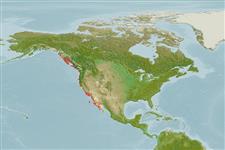Environment: milieu / climate zone / depth range / distribution range
Ecología
marino; oceanodromo (Ref. 51243); rango de profundidad 0 - 18 m (Ref. 2850). Temperate; 58°N - 24°N, 155°W - 111°W
Eastern Pacific: Alaska to Magdalena Bay, Baja California. Not common north of Point Conception (Ref. 11484).
Tamaño / Peso / Age
Maturity: Lm ? range ? - ? cm
Max length : 145 cm FL macho / no sexado; (Ref. 40637); peso máximo publicado: 12.0 kg (Ref. 40637); edad máxima reportada: 12 años (Ref. 56049)
Short description
Claves de identificación | Morfología | Morfometría
Espinas dorsales (total) : 6; Radios blandos dorsales (total) : 9 - 10; Espinas anales: 1; Radios blandos anales: 8 - 9. Color bluish or brownish dorsally, silvery ventrally (Ref. 6885).
Usually near shore or near the surface (Ref. 2850). Often in small schools (Ref. 2850). Young enter bays (Ref. 2850). Feed mainly on other fishes (Ref. 2850). Pelagic spawners (Ref. 56049). Migrate south from the California coast during autumn, but may remain in front of the Mexican coast throughout the year (Ref. 9345). Utilized fresh, dried or salted and frozen; eaten broiled and baked (Ref. 9988). Considered as potentially dangerous due to its large, sharp teeth and aggressive disposition, though there are no reports of attacks (Ref. 9988).
Pelagic spawner (Ref. 56049).
Eschmeyer, W.N., E.S. Herald and H. Hammann, 1983. A field guide to Pacific coast fishes of North America. Boston (MA, USA): Houghton Mifflin Company. xii+336 p. (Ref. 2850)
IUCN Red List Status (Ref. 130435)
Threat to humans
Traumatogenic (Ref. 13513)
Human uses
Pesquerías: comercial; pesca deportiva: si
Herramientas
Special reports
Download XML
Fuentes de Internet
Estimates based on models
Preferred temperature (Ref.
123201): 8.9 - 23.1, mean 12.4 °C (based on 212 cells).
Phylogenetic diversity index (Ref.
82804): PD
50 = 0.5000 [Uniqueness, from 0.5 = low to 2.0 = high].
Bayesian length-weight: a=0.00724 (0.00339 - 0.01546), b=2.92 (2.74 - 3.10), in cm total length, based on LWR estimates for this Genus-body shape (Ref.
93245).
Nivel trófico (Ref.
69278): 4.5 ±0.80 se; based on food items.
Generation time: 7.9 ( na - na) years. Estimated as median ln(3)/K based on 1
growth studies.
Resiliencia (Ref.
120179): Medio, población duplicada en un tiempo mínimo de 1.4-4.4 años (K=0.14; tm=2-3; tmax=12; Fec=42,000).
Fishing Vulnerability (Ref.
59153): High to very high vulnerability (69 of 100).
